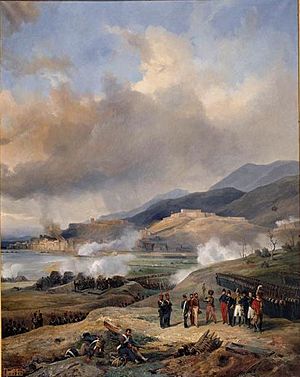Siege of Tortosa (1810–1811) facts for kids
Quick facts for kids Siege of Tortosa (1810) |
|||||||
|---|---|---|---|---|---|---|---|
| Part of Peninsular War | |||||||
 Le général de division Suchet, commandant le 3ème corps de l'armée d'Espagne, reçoit la capitulation de la ville de Tortosa, 2 janvier 1811. Oil painting by Jean-Charles-Joseph Rémond, 1837 (Palace of Versailles) |
|||||||
|
|||||||
| Belligerents | |||||||
| Commanders and leaders | |||||||
| Strength | |||||||
| 12,000 | 11,000 | ||||||
| Casualties and losses | |||||||
| 1,000 | 11,000 | ||||||
The Siege of Tortosa was an important battle that happened during the Peninsular War. This war was part of the bigger Napoleonic Wars in Europe. The siege took place in the city of Tortosa, which is in Catalonia, Spain.
The battle was fought between the French army and the Spanish defenders. The French army was led by General Louis Gabriel Suchet. The Spanish defenders were led by General Lilli, also known as Conde de Alacha. The siege lasted from December 19, 1810, to January 2, 1811.
What Led to the Siege?
The French army wanted to take over the region of Aragon in Spain. The Siege of Tortosa was one of the first big steps in their plan to conquer this area.
The Siege of Tortosa
The siege happened very quickly. Tortosa is a city located on the Ebro River. It is about 80 kilometers (50 miles) southwest of another important city, Tarragona.
During the siege, a French officer named Colonel Pierre-Michel Rouelle played a key role. He successfully stopped two attacks by the Spanish defenders. These attacks happened on December 24 and December 28, 1810. His actions were praised by his commanders.
Finally, on January 2, 1811, General Alacha and the Spanish forces surrendered to the French. This meant the French army won the battle.
What Happened After the Siege?
After the French won the Siege of Tortosa, they continued their plan to conquer Aragon. The next major battle in this campaign was the Battle of El Pla.
See also
 In Spanish: Sitio de Tortosa (1810) para niños
In Spanish: Sitio de Tortosa (1810) para niños

